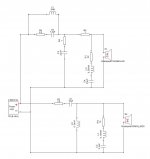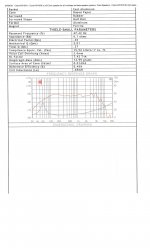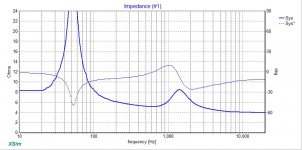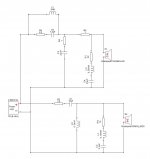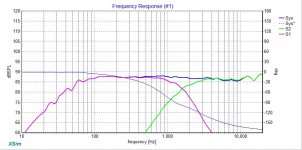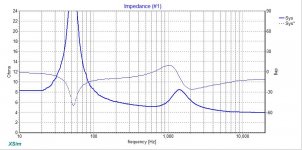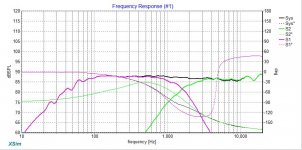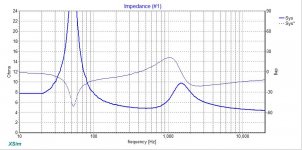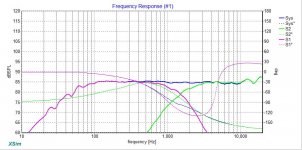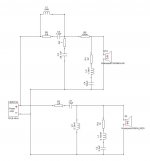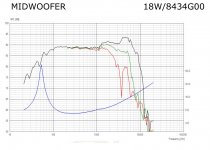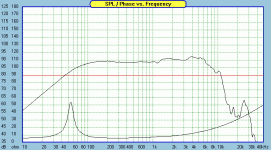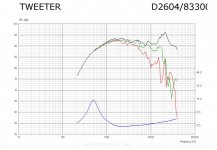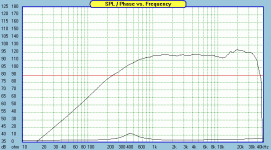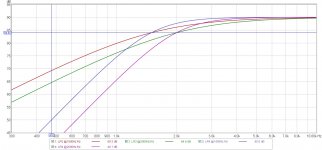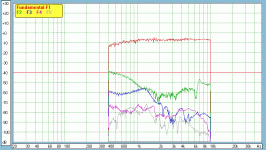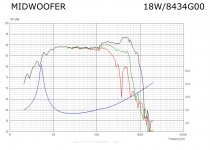Hi To All,
I have begun building 2way floorstanding speakers approximately 27l. The Discovery W18 build from Troels Gravesen using Scanspeak drivers intrigues me. The build will be similar but not exact. I have started experimenting with Xsim and SplTrace to gather frd. files. If anyone cares to critque my attempt at crossover design, it would be much appreciated (newbie alert). My goals are to come up with a design on paper that will sound very good. Once I have acquired the necessary test equipment then further system tweaking will be performed. The crossovers will be enclosed outside the speaker cabs in their own small box to make later adjusting very easy. Thanks in advance!
Best Regards,
Rich
I have begun building 2way floorstanding speakers approximately 27l. The Discovery W18 build from Troels Gravesen using Scanspeak drivers intrigues me. The build will be similar but not exact. I have started experimenting with Xsim and SplTrace to gather frd. files. If anyone cares to critque my attempt at crossover design, it would be much appreciated (newbie alert). My goals are to come up with a design on paper that will sound very good. Once I have acquired the necessary test equipment then further system tweaking will be performed. The crossovers will be enclosed outside the speaker cabs in their own small box to make later adjusting very easy. Thanks in advance!
Best Regards,
Rich
Attachments
JReave,
I attached FR plot with phase curve added. Is that what you were looking for? As for bsc, I have not ran simulations with that in mind. I'm not sure how much to figure in for bass loss. I'm still trying to get my head around some this stuff. The baffle width on my cabinets is 10" and I will be using a 7" midwoofer. Hope that added information helps. Thanks so much!
Best Regards,
Rich
I attached FR plot with phase curve added. Is that what you were looking for? As for bsc, I have not ran simulations with that in mind. I'm not sure how much to figure in for bass loss. I'm still trying to get my head around some this stuff. The baffle width on my cabinets is 10" and I will be using a 7" midwoofer. Hope that added information helps. Thanks so much!
Best Regards,
Rich
Attachments
Here is FR plot with bsc considered. I adjusted mod sensitivity set to -3 db. I don't know if that's a typical amount of loss. But anyway, I thought it would not hurt to show what that looks like.
Best Regards,
Rich
Best Regards,
Rich
Attachments
Use the ground symbol so you don't have to clutter your schematic with returns to the amp (-) terminal.
Figure approximately 1.3-1.5" of distance between tweeter and woofer, not known until you have the drivers in a baffle. That will throw off much there. 🙂
Don't rely on SPL tracing alone, and especially don't rely on manufacturer's T/s specs. I think ScanSpeak puts the interns on them, they're never even close.
Best,
Erik
Figure approximately 1.3-1.5" of distance between tweeter and woofer, not known until you have the drivers in a baffle. That will throw off much there. 🙂
Don't rely on SPL tracing alone, and especially don't rely on manufacturer's T/s specs. I think ScanSpeak puts the interns on them, they're never even close.
Best,
Erik
Hi To All,
I have begun building 2way floorstanding speakers approximately 27l. The Discovery W18 build from Troels Gravesen using Scanspeak drivers intrigues me. The build will be similar but not exact. I have started experimenting with Xsim and SplTrace to gather frd. files. If anyone cares to critque my attempt at crossover design, it would be much appreciated (newbie alert). My goals are to come up with a design on paper that will sound very good. Once I have acquired the necessary test equipment then further system tweaking will be performed. The crossovers will be enclosed outside the speaker cabs in their own small box to make later adjusting very easy. Thanks in advance!
Best Regards,
Rich
Thanks Erik,
Would you recommend another driver choice like Dayton Audio that has more reliable specs. I have no way currently to test drivers so I'm at the mercy of manufactures data sheets.
Best Regards,
Rich
Would you recommend another driver choice like Dayton Audio that has more reliable specs. I have no way currently to test drivers so I'm at the mercy of manufactures data sheets.
Best Regards,
Rich
Thanks Erik,
Would you recommend another driver choice like Dayton Audio that has more reliable specs. I have no way currently to test drivers so I'm at the mercy of manufactures data sheets.
Best Regards,
Rich
Rich,
ScanSpeak makes good drivers. They just kind of suck at spec'ing the T/s parameters.
If you want to design crossovers virtually, then yes, Dayton data is pretty good, but still won't have any idea about the actual baffle step compensation you'll need.
If you want to make something real, I'd recommend the OmniMic + DATS V2 combination. If that's too pricey, Room EQ Wizard + DATS V2 ($99) with some sort of measurement mic as a solution.
Given a choice between pricey drivers you can't measure, and spending the money on modest drivers + measurement tools I'd go with the latter.
A very good compromise below the SS is the SB Acoustics Satori line. You could find something in that line, and pay for the measurement tools. 🙂 OR buy something completely spec'd from a kit.
There's a permanent thread at the top of this forum about building speakers without measurements. You may want to go look there. Also, one thing you'll have to do is know the speaker distances. That's something you can't avoid for good crossover design. Add 1.3" to your current crossover and you'll see the problem . Instructions are here if you have any sort of measurements tools.
Best,
Erik
Last edited:
Thanks Again Erik,
That gives me some pointed information to consider. I follow your posts on this forum and value your opinion! I'm still in cabinet construction mode, so there is some time to decide on drivers, crossover topology, etc. That said, it nice to have a plan in place.
Best Regards,
Rich
That gives me some pointed information to consider. I follow your posts on this forum and value your opinion! I'm still in cabinet construction mode, so there is some time to decide on drivers, crossover topology, etc. That said, it nice to have a plan in place.
Best Regards,
Rich
Tools gives you the most alternatives and most accurate guages.
I've also found Madisound's and PE's cabinet recommendations pretty useful when it comes to cabinet sizing.
Best,
Erik
I've also found Madisound's and PE's cabinet recommendations pretty useful when it comes to cabinet sizing.
Best,
Erik
Thanks Erik,
I'm going to invest in some measuring tools before I get to far into this project. I might need to invest in a forklift if I make these cabs any heavier (lol). Without drivers, my first cab weighs 50 lbs.
Best,
Rich
I'm going to invest in some measuring tools before I get to far into this project. I might need to invest in a forklift if I make these cabs any heavier (lol). Without drivers, my first cab weighs 50 lbs.
Best,
Rich
Thanks Erik,
I'm going to invest in some measuring tools before I get to far into this project. I might need to invest in a forklift if I make these cabs any heavier (lol). Without drivers, my first cab weighs 50 lbs.
Best,
Rich
Man, I'm going to hate to see what you build for your crossover boxes.... 😀
Erik
Erik,
Its a good thing winter is coming to an end or I really might get carried away. The wife already believes I lost it entirely (LOL). Maybe dismantling a perfectly good pair of JBL New Decade Series speakers convinced her.
Best,
Rich
Its a good thing winter is coming to an end or I really might get carried away. The wife already believes I lost it entirely (LOL). Maybe dismantling a perfectly good pair of JBL New Decade Series speakers convinced her.
Best,
Rich
I'm not going to disagree with Eric about many companies' TS parameters being somewhat off, but we should distinguish between those and the FR and Z measurements which in the case of your chosen drivers are not bad at all.
Besides measuring drivers in the cabinet, another reliable way to proceed with simulations only is to use a reliable 3rd party's measurements, Zaph Audio in particular being an excellent source. Below are the comparisons for eg. for your drivers which are actually pretty close.
Now it looks like you actually have a decent handle on the actual xo's (the tanking cap and resistor on the woofer inductor I would call above beginner level - although I'm not actually sure it's needed in this case) but you don't have a good grasp on the correct simulation procedure.
In no particular order:
- Driver phase in the xo region should overlap but your's is all wonky, which leads me to think you have not extracted minimum phase from your frd and zma files.
- Have you entered the acoustic offsets as well?
- The sim has to account for baffle step loss which is not the same as just reducing the overall woofer level by 3dB if that's what you've done.
- Do you have a target xo point and target xo slopes? These are things that it's important for a beginner to understand based on things like a driver's natural rolloff, directivity, resonant frequency, cone resonances and harmonic distortion. I think there is a small problem as a beginner starting out with XSim in that, although it's a great program, it doesn't offer you easy access to target slopes although there are ways to create or import them.
- Another thing to consider is the sum of all your off-axis responses (the power response) not just the direct on-axis FR, and again this isn't found in XSim. A perfectly flat on-axis response looks ideal but it may not be depending on what the power response looks like. For these reasons, I also recommend that you learn PCD or WinPCD as well.
- What is R6 for in the woofer circuit? Generally, adding series resistance to a woofer circuit is a no-no.
There is some good info in the last link that Eric gave you in post #9. Have a look in the Speaker Building Bible too starting in the xo section. Look in particular at the simulation process like:
https://sites.google.com/site/undefinition/simulated-measurements
FRD Consortium tools guide
And Wolf's how to's.
Re baffle step loss, there is a way in Response Modeler to alter its level. When you reach this point, get back to me if you need help or confirmation on that one.
Hope that helps.
Besides measuring drivers in the cabinet, another reliable way to proceed with simulations only is to use a reliable 3rd party's measurements, Zaph Audio in particular being an excellent source. Below are the comparisons for eg. for your drivers which are actually pretty close.
Now it looks like you actually have a decent handle on the actual xo's (the tanking cap and resistor on the woofer inductor I would call above beginner level - although I'm not actually sure it's needed in this case) but you don't have a good grasp on the correct simulation procedure.
In no particular order:
- Driver phase in the xo region should overlap but your's is all wonky, which leads me to think you have not extracted minimum phase from your frd and zma files.
- Have you entered the acoustic offsets as well?
- The sim has to account for baffle step loss which is not the same as just reducing the overall woofer level by 3dB if that's what you've done.
- Do you have a target xo point and target xo slopes? These are things that it's important for a beginner to understand based on things like a driver's natural rolloff, directivity, resonant frequency, cone resonances and harmonic distortion. I think there is a small problem as a beginner starting out with XSim in that, although it's a great program, it doesn't offer you easy access to target slopes although there are ways to create or import them.
- Another thing to consider is the sum of all your off-axis responses (the power response) not just the direct on-axis FR, and again this isn't found in XSim. A perfectly flat on-axis response looks ideal but it may not be depending on what the power response looks like. For these reasons, I also recommend that you learn PCD or WinPCD as well.
- What is R6 for in the woofer circuit? Generally, adding series resistance to a woofer circuit is a no-no.
There is some good info in the last link that Eric gave you in post #9. Have a look in the Speaker Building Bible too starting in the xo section. Look in particular at the simulation process like:
https://sites.google.com/site/undefinition/simulated-measurements
FRD Consortium tools guide
And Wolf's how to's.
Re baffle step loss, there is a way in Response Modeler to alter its level. When you reach this point, get back to me if you need help or confirmation on that one.
Hope that helps.
Attachments
Thanks JReave,
You are correct in your statements about not having a complete grasp of Xsim. To my knowledge, there is no help manuals to speed up the learning curve so for a beginner it is trial and error (or at least appears so). It's great that people on this forum are willing to help others or I would not stand a chance.
To answer some of your questions:
1) My target xo region is between 1,400 khz to 1,600 khz. I'm trying to look at advertised response charts and see were best to crossover at.
2) I have not entered acoustic offsets. (Help needed on that one). I saw it under where you retrieve frd. and zma. files.
3) I also did as you suspected and lowered woofer by 3 db to account for baffle step loss.
There is valuable information that has been presented between you and Erik. I will look at the links you suggested and keep on trying to learn more about this stuff. Thanks a million!
Best Regards,
Rich
You are correct in your statements about not having a complete grasp of Xsim. To my knowledge, there is no help manuals to speed up the learning curve so for a beginner it is trial and error (or at least appears so). It's great that people on this forum are willing to help others or I would not stand a chance.
To answer some of your questions:
1) My target xo region is between 1,400 khz to 1,600 khz. I'm trying to look at advertised response charts and see were best to crossover at.
2) I have not entered acoustic offsets. (Help needed on that one). I saw it under where you retrieve frd. and zma. files.
3) I also did as you suspected and lowered woofer by 3 db to account for baffle step loss.
There is valuable information that has been presented between you and Erik. I will look at the links you suggested and keep on trying to learn more about this stuff. Thanks a million!
Best Regards,
Rich
JReave,
I have been looking at the link to working within Jeff Bagby's program. It appears that I need to learn that program as well. It does seem possible to achieve good results without testing equipment if a person does not miss any critical steps. Without your help I would have crash landed (LOL). I will read more in depth with regard to Speaker Building Bible and the other reads. May not be tonight my head is now spinning.
Thanks Again,
Rich
I have been looking at the link to working within Jeff Bagby's program. It appears that I need to learn that program as well. It does seem possible to achieve good results without testing equipment if a person does not miss any critical steps. Without your help I would have crash landed (LOL). I will read more in depth with regard to Speaker Building Bible and the other reads. May not be tonight my head is now spinning.
Thanks Again,
Rich
1) My target xo region is between 1,400 khz to 1,600 khz. I'm trying to look at advertised response charts and see were best to crossover at.
As a RoT (Rule of Thumb) for the tweeter, you want to cross a minimum of 1 octave and preferably 2 octaves above the resonant frequency. With yours, 2 octaves puts you at about 1900Hz, but look at the target slopes I've attached below - this really depends on what slopes you choose as well as how loud your speaker is intended to play at.
You also want to look at the tweeter's distortion. Third order starts rising steeply at about 3kHz (2nd graph). With this tweeter, I would personally try to keep it under the -70dB mark so I would say 1600Hz to 2000Hz with a 4th order slope would be preferable.
The RoT for the woofer is to stay an octave or 2 away from any cone breakup but which often actually isn't that significant with ScanSpeak drivers. The other RoT is about directivity whereby you want to keep the xo point below the frequency at which the 45 degree offf-axis FR drops 3dB below the on-axis point. Now ScanSpeak annoys me here because they don't label their graphs properly (3rd graph below: 30* & 60* I think) so I think we are looking at about 1800Hz, maybe 2000Hz.
Conclusion: I'd shoot for LR4 between 1600Hz and 1800Hz.
2) I have not entered acoustic offsets. (Help needed on that one). I saw it under where you retrieve frd. and zma. files.
Again see Wolf's tutorials, although since then it's been suggested that the more appropriate point is where the voice coil meets the cone which is usually pretty close to the spider. Zoom in on the driver diagram in the pdf's until it measures actual size and then take the measurement off your computer screen.
3) I also did as you suspected and lowered woofer by 3 db to account for baffle step loss.
Yea, that won't work because the baffle step loss is not consistent across the whole FR. Just use the normal simulated 6dB baffle diffraction FR right now for your modeling purposes.
I'm not sure if you can get through the process correctly without using Excel. J Bagby's PCD and Response Modeler are particularly useful. Recent Windows updates 😡 however made some of the programs malfunction so if this occurs, see here:
PCD7 all of a sudden stopped working: any help?
This is also a great new tracing program. Saves loads of time:
New automatic graph tracing program
Also double check your box volume for the Scan woofer based on Zaph's TS parameters. If that's out and with your cabinet work already begun, that could be a reason to consider another woofer.
Keep asking questions btw if you get stuck.🙂
Attachments
JReave,
Wow! The information you provided is awesome. I will continue to absorb what you have provided. Today, I have downloaded Jeff Bagby's response modeler and Spl copy (looks easier then SplTrace). Now I just need to find 3rd party Ts parameters for these two drivers. I had previously used manufacture data to model the woofer in Winisd. It indeed looked good but not sure about data accuracy. I have yet to find them on Zaph's site. I will look again. Then start learning Response Modeler. Very exciting stuff!
Thanks Again!
Rich
Wow! The information you provided is awesome. I will continue to absorb what you have provided. Today, I have downloaded Jeff Bagby's response modeler and Spl copy (looks easier then SplTrace). Now I just need to find 3rd party Ts parameters for these two drivers. I had previously used manufacture data to model the woofer in Winisd. It indeed looked good but not sure about data accuracy. I have yet to find them on Zaph's site. I will look again. Then start learning Response Modeler. Very exciting stuff!
Thanks Again!
Rich
Hey Rich, look at Zaph's Blog too, about half way down the page.
I don't know what it was but I never got SPLCopy to work for me. No problem with SPLTrace and it gets faster once you figure out a few tricks (Trace -> Options -> Use Trace Limits -> you don't always need to start at 20Hz and you don't need to use 400 trace points for a decently smooth FR!! and even less for a simple and partial impedance curve). But try the other tracing program I linked above. Very sweet. Very fast. Very easy to use. Although occasionally it doesn't like certain graphs and then I go back to SPLTrace.
I don't know what it was but I never got SPLCopy to work for me. No problem with SPLTrace and it gets faster once you figure out a few tricks (Trace -> Options -> Use Trace Limits -> you don't always need to start at 20Hz and you don't need to use 400 trace points for a decently smooth FR!! and even less for a simple and partial impedance curve). But try the other tracing program I linked above. Very sweet. Very fast. Very easy to use. Although occasionally it doesn't like certain graphs and then I go back to SPLTrace.
- Status
- Not open for further replies.
- Home
- Loudspeakers
- Multi-Way
- Xsim crossover critique
